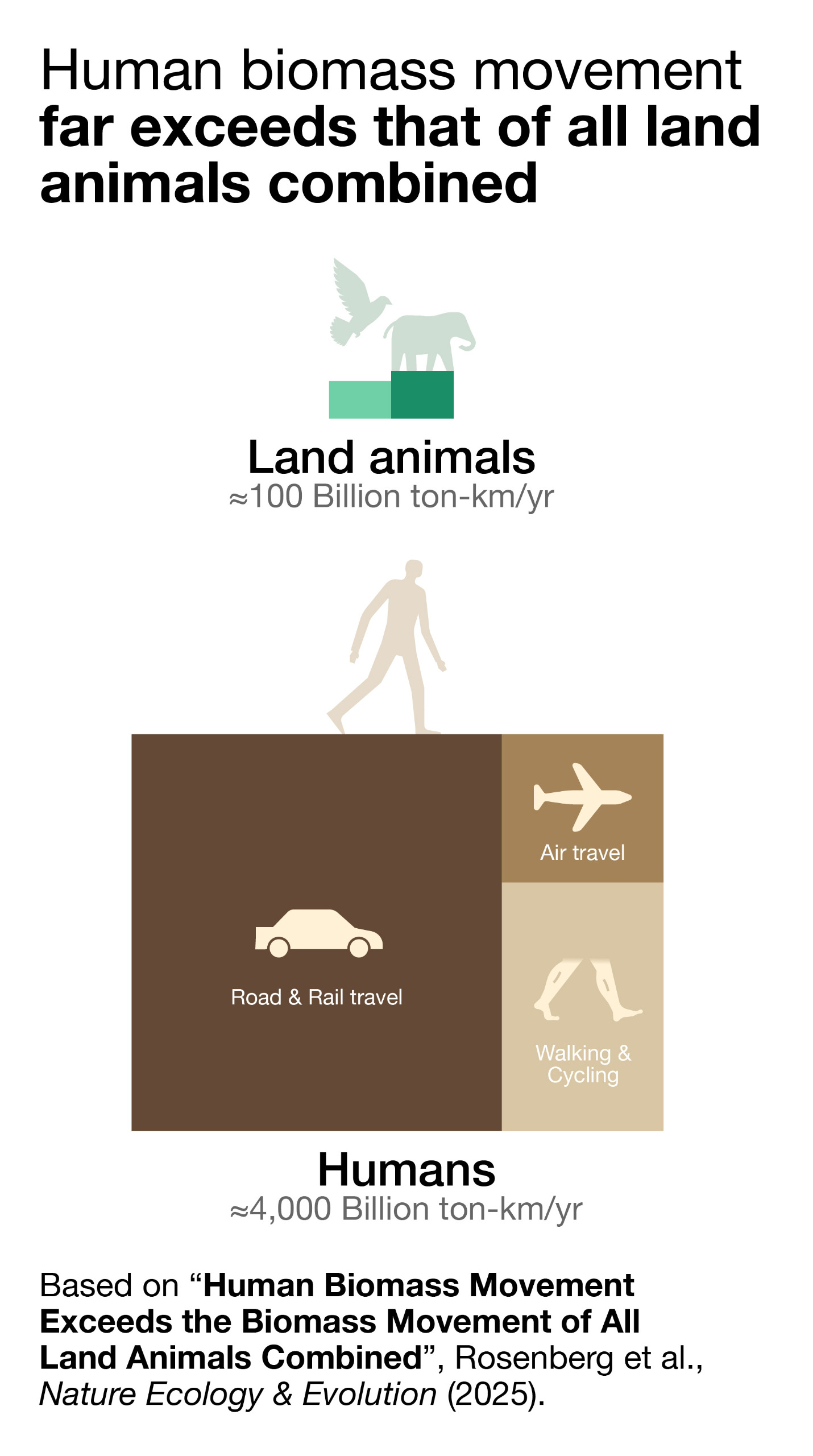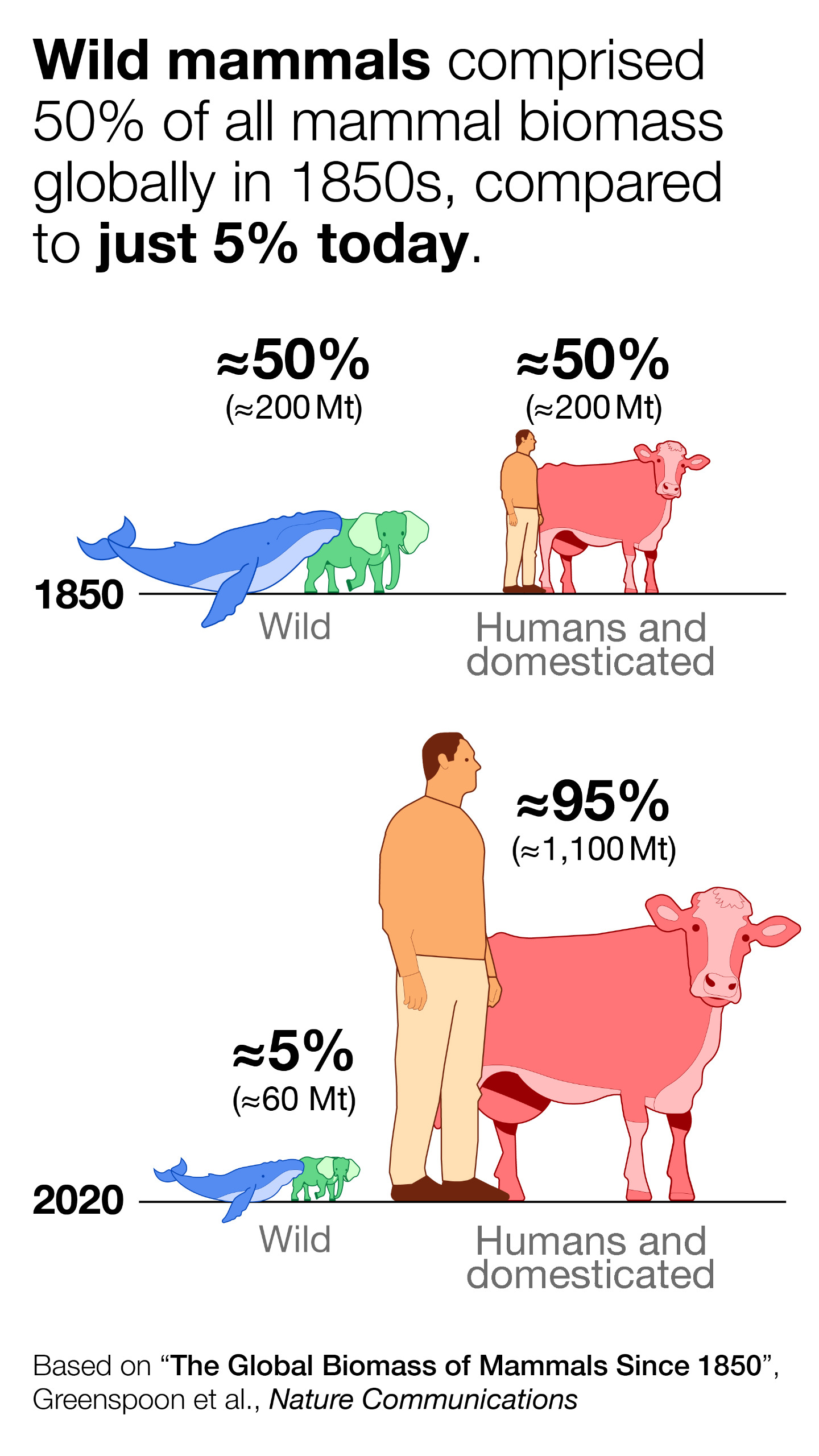The great migrations of animals across the African savannah or birds between hemispheres are dwarfed by the movement of humans, a new study has calculated. That’s a consequence of humans and domesticated animals dominating biomass on land. Despite winter flights from colder climates to the Mediterranean or Caribbean, humans do not present as impressive a migratory sight as vast herds of wildebeest and zebra, but when it comes to distance times body mass, nothing on land or in the air comes close.
A great many animals are much bigger than humans, so it’s easy to assume they must collectively outweigh us, but that’s no longer true. The populations of most large wild mammals are shrinking, and the few exceptions like bison and humpback whales are rebounding from near extinction but still far below their numbers two centuries ago.
A study led by Weizmann Institute of Science PhD student Lior Greenspoon roughly matches previous research in showing humans now make up a third of mammalian biomass, with our livestock making up most of the rest. Wild mammals, whales included, are just 5 percent.
The same authors also investigated something new, considering the movement of biomass, measured by comparing the mass of an average member of a species, but the number alive today and the distance travelled annually. The results make for sobering reading.
The migration of a million grazing animals, many weighing much more than a human, across Africa makes for spectacular documentaries. Yet despite this awesome spectacle, the authors find it’s roughly equivalent in biomass movement to Hajj or the FIFA World Cup. The human bodies in motion may be smaller, but many of them travel much further with the help of intercontinental aircraft.
Some other comparisons are also surprising. There are around two million arctic terns on Earth, and they migrate almost from one pole to the other and back again each year. Yet their total biomass movement is less than that of gray wolves, 16 and 30 million ton-kilometers per year, respectively.
However, all this is small compared to the sum motion of humans, whether it is daily trips to work and back, or less frequent but longer holidays. Sedentariness may be a problem for human health, but with the aid of planes, trains, and automobiles, we travel a lot further than most animals each year. The exceptions are migratory birds, which don’t have much body mass to move, and the larger whales, now few in number.
Consequently, Greenspoon and colleagues estimate humans move 4,000 billion ton-kilometers a year (Gt km yr-1), meanwhile all wild land animals combined amount to about 100 Gt km yr-1, about 40 times less. Wild land mammals (not counting bats) are thought to move 30 Gt km yr-1, of which 23 percent is African bush elephants.

Human foot traffic far outweighs the movement of all land and air animals, and cars and planes account for even more.
Image Credit: Itai Raveh
In one astonishing statistic, the authors note, “Today, a large power station generates as much power as is used for locomotion by all wild land mammals combined.”
Birds’ smaller masses but greater numbers and distances moved balance out, to produce a similar estimate to land mammals, although the error margins here are even larger, reaching as high as 130 Gt km yr−1.
Most of the wild animal biomass on land is in the form of invertebrates, mostly insects, but few travel long distances, so the biomass movement is only a little higher at 40 Gt km yr-1.
Ocean movements are greater, but not necessarily the ones you think. Certainly, humpback whale migrations outdo all land mammals and birds on this measure, but they are still roughly matched by the movements of the population of Germany alone. Fish, by virtue of their far greater numbers, move about 30,000 Gt km yr-1, more than seven times as much as humans. Zooplankton make up the largest store of biomass on Earth, but move so little that their figure is around a quarter of ours.
It’s not just the ease of travel provided by cars and planes that make humans the planet’s biggest movers. Our foot traffic alone is far beyond any other species, and equal to about six times the biomass movement of wild land animals (insects included) and birds.
This is all very recent. In 1850, there were only about a seventh as many humans (and our body mass was smaller still), and most people seldom journeyed far from their place of birth. Meanwhile, the biomass movement of wild land animals was around double what it is today, before our mass slaughter of the larger animals and destruction of migratory bird habitat had begun in force. Ocean movement has decreased even more as we hunted the whales and overfished the oceans.
Cattle and sheep account for most of the modern large animal biomass, but are increasingly confined to feedlots, rather than allowed to range.

As the biomass of wild animals shrinks, that of humans and cattle grows.
Image Credit: Itai Raveh
To reach these estimates, the authors drew on hundreds of published studies estimating the number and weight of various animals and their movements. “Only a fraction of species was monitored for travelling distances,” they acknowledge, but add, “However, they represent characteristic movement patterns of central animal groups and the total biomass of many species is small, allowing us to make order-of-magnitude estimates of global biomass movement.”
There’s a price to pay for this shift. Marine mammals play a vital role in fertilizing parts of the ocean that would otherwise be watery deserts, lacking the iron to support life. The phytoplankton that scavenge the nutrients in whale feces draw carbon from the atmosphere and form the base of the ocean food chain. Yet these migrations have shrunk an estimated 70 percent since 1850, thanks to the deliberate killing of whales for more than a century, and modern threats like driftnets and ship strikes.
Even the 1850 figure, at least for land animals, was a small fraction of what it would have been in the late Pleistocene, before the extinction of mammoths, diprotodons, and their like slashed land mammal biomass. Today, wild mammals weigh a tenth of what they did back then.
The estimates for human movement include only our own body mass, not the vastly greater mass of the metal shells in which most of our movement now takes place.
The work has been published in two papers, in Nature Ecology & Evolution and Nature Communications, respectively.
Source Link: Human Movement Around Earth Over 40 Times Greater Than That Of All Wild Land Animals Combined